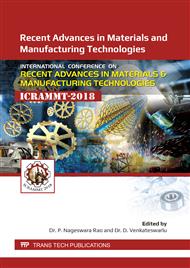[1]
A. Bouzouita , D. Notta-Cuvier, R. Delille, F. Lauro, J.-M. Raquez, P. Dubois, Design of toughened PLA based material for application in structuressubjected to severe loading conditions. Part 2. Quasi-static tensile tests and dynamic mechanical analysis at ambient and moderately high temperature,, Polymer Testing 57, 2017, pp.235-244.
DOI: 10.1016/j.polymertesting.2016.11.034
Google Scholar
[2]
K. M. Nampoothiri, N. R. Nair, R. P. John, An overview of the recent developments in polylactide (PLA) research,, Bioresource Technology 101, 2010, p.8493–8501.
DOI: 10.1016/j.biortech.2010.05.092
Google Scholar
[3]
R. Auras, B. Harte, S. Selke, An overview of polylactides as packaging materials,, Macromol. Biosci. 4, 2004, p.835–864.
DOI: 10.1002/mabi.200400043
Google Scholar
[4]
M.S. Lopes, A.L. Jardini, R.M. Filho, Poly (lactic acid) production for tissue engineering Applications,, Procedia Eng. 42, 2012, pp.1402-1413.
DOI: 10.1016/j.proeng.2012.07.534
Google Scholar
[5]
X. Li, C. Guo, X. Liu, L. Liu, J. Bai, F. Xue, P. Lin, C. Chu, Impact behaviors of poly-lactic acid based biocomposite reinforced with unidirectional high-strength magnesium alloy wires,, Progress in Natural Science: Materials International 24, 2014, p.472–478.
DOI: 10.1016/j.pnsc.2014.08.003
Google Scholar
[6]
B. Bax, J. Mussig, Impact and tensile properties of PLA/Cordenka and PLA/flax composites,, Compos. Sci. Technol. 68, 2008, p.1601–1607.
DOI: 10.1016/j.compscitech.2008.01.004
Google Scholar
[7]
Y. Lemmouchi, M. Murariu, A.M.D. Santos, A.J. Amass, E. Schacht, P. Dubois, Plasticization of poly(lactide) with blends of tributyl citrate and low molecular weight poly (D, L-lactide)-b-poly (ethylene glycol) copolymers,, Eur. Polym. J. 45, 2009 p.2839–2848.
DOI: 10.1016/j.eurpolymj.2009.07.006
Google Scholar
[8]
C. Aversa, M. Barletta, E. Pizzi, M. Puopolo, S. Vesco, Wear resistance of injection moulded PLA-talc engineered bio-composites: Effect of material design, thermal history and shear stresses during melt processing,, Wear 390–391, 2017, 184–197.
DOI: 10.1016/j.wear.2017.08.001
Google Scholar
[9]
Chin-San Wu, Hsin-Tzu Liao, Study on the preparation and characterization of biodegradable polylactide/multi-walled carbon nanotubes nanocomposites,, Polymer 48, 2007, pp.4449-4458.
DOI: 10.1016/j.polymer.2007.06.004
Google Scholar
[10]
D. Lahiri, F. Rouzaud, T. Richard, A. K. Keshri, S. R. Bakshi, L. Kos, A. Agarwal, Boron nitride nanotube reinforced polylactide–polycaprolactone copolymer composite: Mechanical properties and cytocompatibility with osteoblasts and macrophages in vitro, Acta Biomaterialia 6 (2010) 3524–3533.
DOI: 10.1016/j.actbio.2010.02.044
Google Scholar
[11]
M. p. Ho, K. t. Lau, H. Wang, D. Hui, Improvement on the properties of polylactic acid (PLA) using bamboo charcoal particles,, Composites Part B 81, 2015, pp.14-25.
DOI: 10.1016/j.compositesb.2015.05.048
Google Scholar
[12]
M. Murariu, A. D. S. Ferreira, P. Degee, M. Alexandre, P. Dubois, Polylactide compositions. Part 1: Effect of filler content and size on mechanical properties of PLA/calcium sulfate composites,, Polymer 48, 2007, pp.2613-2618.
DOI: 10.1016/j.polymer.2007.02.067
Google Scholar
[13]
K. Piekarska, E. Piorkowska, J. Bojda, The influence of matrix crystallinity, filler grain size and modification on properties of PLA/calcium carbonate composites,, Polymer Testing 62, 2017, pp.203-209.
DOI: 10.1016/j.polymertesting.2017.06.025
Google Scholar
[14]
M. Ramos, E. Fortunati, M. Peltzer, A. Jimenez, J. M. Kenny, M. C. Garrigos, Characterization and disintegrability under composting conditions of PLA-based nanocomposite films with thymol and silver nanoparticles,, Polymer Degradation and Stability 132, 2016, pp.2-10.
DOI: 10.1016/j.polymdegradstab.2016.05.015
Google Scholar
[15]
J. O. Akindoyo, M. D. H. Beg, S. Ghazali , H. P. Heim, M. Feldmann, Effects of surface modification on dispersion, mechanical, thermal and dynamic mechanical properties of injection molded PLA-hydroxyapatite composites,, Composites: Part A 103, 2017, p.96–105.
DOI: 10.1016/j.compositesa.2017.09.013
Google Scholar
[16]
G. Sahu, M. S. Rajput, U. N. Sahu, S. P. Mahapatra, Production (Synthesis) and Rheological Properties of Poly Lactic Acid (PLA) for Food Packaging and Biomedical Application,, Proceedings of the 10th International Conference On Precision, Meso, Micro and Nano Engineering, pp.532-534.
Google Scholar
[17]
S. Girdthep, W. Sankong, A. Pongmalee, T. Saelee, W. Punyodom, P. Meepowpan, P. Worajittiphon, Enhanced crystallization, thermal properties, and hydrolysis resistance of poly(l-lactic acid) and its stereocomplex by incorporation of graphene nanoplatelets,, Polymer Testing, Volume 61, 2017, pp.229-239.
DOI: 10.1016/j.polymertesting.2017.05.009
Google Scholar


